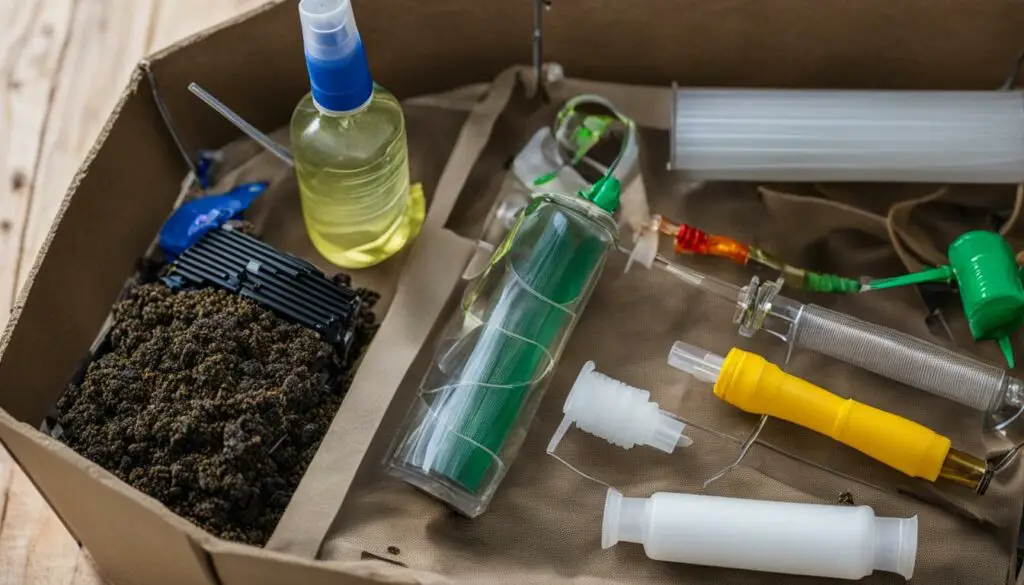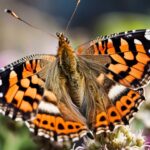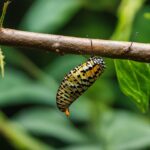Welcome to my comprehensive guide on butterfly rearing kit essentials! Whether you’re a beginner or a seasoned butterfly enthusiast, this article will provide you with all the necessary tools, resources, and supplies to successfully raise and nurture butterflies at home or at school.
Key Takeaways:
- Learn about the essential tools and supplies needed for successful butterfly rearing.
- Explore resources for obtaining milkweed seeds and plants, the primary food source for caterpillars.
- Discover different options for caterpillar cages to provide a safe and protected environment.
- Understand the benefits of window cages and clear mesh cages for raising butterflies indoors or outdoors.
- Find recommended books and articles for further educating yourself on butterfly rearing techniques.
Milkweed Seed and Plant Resources
When it comes to raising butterflies, having a reliable supply of milkweed is essential. Milkweed is the sole food source for caterpillars, so it’s important to ensure you always have enough on hand. In this section, I will provide you with information on where to find milkweed seeds, plants, plugs, and cuttings, so you can create a thriving habitat for your caterpillars.
Where to find milkweed seeds?
One of the easiest ways to obtain milkweed seeds is by purchasing them from reputable online retailers. There are several websites dedicated to milkweed seeds, where you can choose from a variety of milkweed species that are suitable for your region. Make sure to select native milkweed species to support the local ecosystem.
“By purchasing milkweed seeds from reputable sources, you can ensure the quality and authenticity of the seeds, increasing the chances of successful germination.”
You can also consider joining local gardening groups or forums where members often exchange or offer milkweed seeds for free. This is a great way to connect with other butterfly enthusiasts and obtain milkweed seeds while also contributing to the conservation of monarch butterflies.
Where to find milkweed plants, plugs, and cuttings?
In addition to seeds, you can purchase milkweed plants, plugs, or cuttings from nurseries and garden centers. These establishments often carry a variety of milkweed species, allowing you to choose the most suitable one for your butterfly rearing needs.
Another option is to reach out to local botanical gardens or nature centers that may offer milkweed plants for sale. These organizations usually prioritize native plants and can provide valuable advice on selecting the right milkweed species for your area.
| Source | Description |
|---|---|
| Online retailers | Purchase milkweed seeds from reputable websites dedicated to milkweed |
| Local gardening groups or forums | Connect with other butterfly enthusiasts and obtain milkweed seeds for free or at a low cost |
| Nurseries and garden centers | Purchase milkweed plants, plugs, or cuttings |
| Botanical gardens or nature centers | Reach out to local establishments that prioritize native plants and offer milkweed for sale |
By utilizing these resources, you can ensure a steady supply of milkweed, providing a lifeline for caterpillars and creating a thriving environment for butterfly rearing.
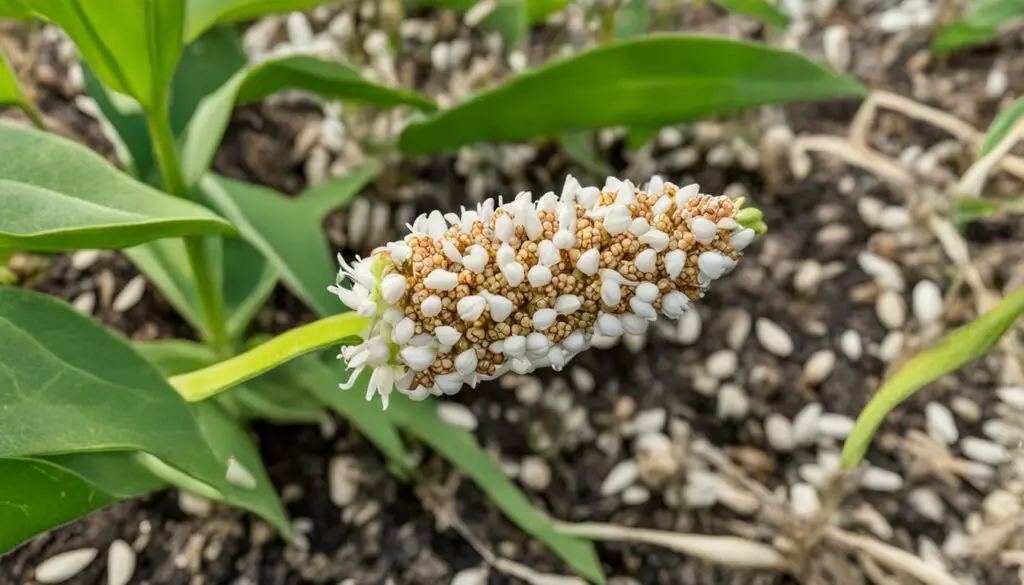
Caterpillar Cages
When it comes to raising butterflies, providing a safe and secure environment for your caterpillars is crucial. Caterpillar cages are essential butterfly rearing supplies that offer protection from predators and allow for easy observation. There are several options available in the market, but it’s important to choose the right cage for your needs.
Pop-up Cages
One popular choice for caterpillar cages is the pop-up variety. These cages are collapsible, making them easy to store when not in use. They come in various sizes to accommodate different caterpillar species and quantities. Pop-up cages are also made from fine mesh, which prevents caterpillars from escaping and keeps out unwanted visitors such as birds and insects.
Additionally, the mesh design allows for proper airflow and ventilation, creating a healthy environment for your caterpillars. These cages are also easy to clean, ensuring the maintenance of a hygienic space for your butterflies to thrive.
Choosing the Right Cage
When selecting a caterpillar cage, consider the size and species of caterpillars you’ll be raising. Larger caterpillars will require more space, while smaller species may need a more compact cage. It’s essential to provide enough room for the caterpillars to move and grow comfortably.
Furthermore, ensure that the cage has a secure closure mechanism to prevent any accidental escapes. Some cages come with zipper closures, while others have velcro or snap fasteners. Choose a cage with a closure that is easy to use and reliable.
Remember, caterpillar cages are an investment in the successful rearing of butterflies. By providing a safe and nurturing environment, you can watch these incredible creatures transform and contribute to their conservation efforts.
Choosing Between Window Cages and Clear Mesh Cages
When it comes to raising butterflies, choosing the right cage is essential. Depending on whether you plan to raise butterflies indoors or outdoors, you may need to decide between window cages or clear mesh cages. Both options have their advantages and it’s important to understand the differences to make an informed choice.
Window Cages
Window cages are a popular choice for indoor butterfly rearing. As the name suggests, these cages are designed to attach directly to a window, allowing you to observe the butterflies up close while providing them with natural light and ventilation. The mesh walls of window cages are typically made of a fine nylon material, ensuring that the butterflies stay securely in the cage while still allowing for optimal airflow.
One of the main benefits of window cages is their convenience. They are easy to set up and require minimal space, making them perfect for small living areas or classrooms. Additionally, window cages often come with a removable feeding dish, simplifying the process of providing nectar or sugar water to your butterflies.
Clear Mesh Cages
If you’re planning to raise butterflies outdoors or have limited access to windows, clear mesh cages are a great alternative. These cages are typically larger and freestanding, offering more space for your butterflies to fly and roam. The walls of clear mesh cages are made of a transparent material, such as polyester or fiberglass, providing excellent visibility and ensuring that your butterflies receive adequate sunlight.
Clear mesh cages are ideal for creating a natural habitat for your butterflies. They often come with removable sleeves that can be attached to the top of the cage, allowing you to place potted plants or cut flowers inside. This not only provides a source of nectar for the butterflies but also adds beauty to their environment.
Comparison Table: Window Cages vs. Clear Mesh Cages
| Window Cages | Clear Mesh Cages | |
|---|---|---|
| Design | Attachable to windows | Freestanding |
| Visibility | Mesh walls | Transparent walls |
| Space | Compact | More spacious |
| Natural Habitat | Limited | Allows for potted plants |
| Feeding | Removable feeding dish | Nectar sources can be added |
| Portability | Easy to move | May require more effort to relocate |
Ultimately, the choice between window cages and clear mesh cages depends on your specific circumstances and preferences. If you have limited space or want to observe your butterflies up close indoors, window cages are the way to go. On the other hand, if you have ample outdoor space and want to create a natural butterfly habitat, clear mesh cages are the better choice. Whichever option you choose, both window cages and clear mesh cages provide a safe and comfortable home for your butterflies throughout their development.
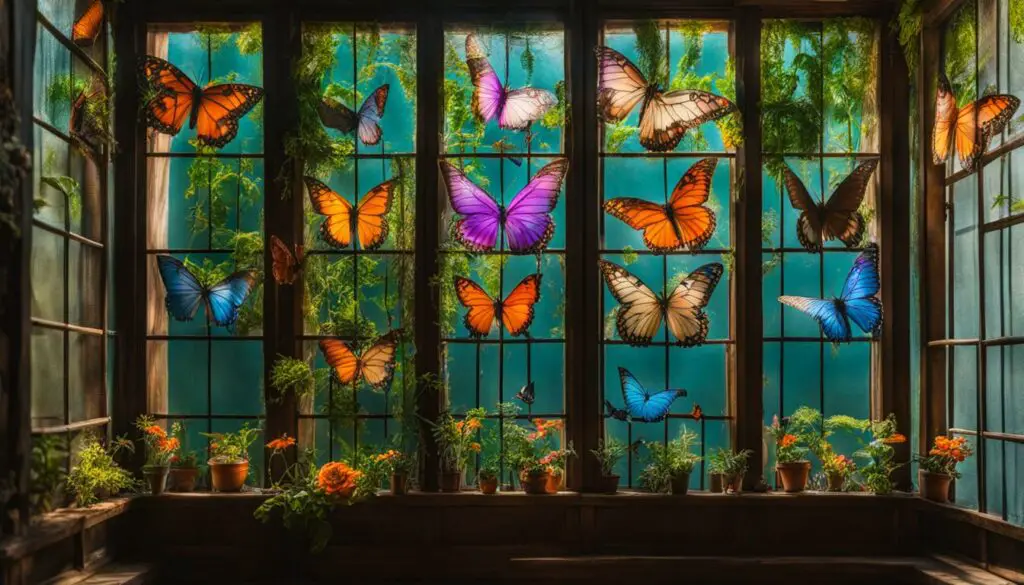
Next, in Section 5, we’ll discuss some informative butterfly raising books that can further enhance your skills and knowledge in butterfly rearing. Stay tuned!
Butterfly Raising Books
As an avid butterfly raiser, I have found that educating myself is key to ensuring the successful growth and development of these delicate creatures. Fortunately, there are several informative books out there that provide step-by-step guides and expert tips for butterfly raising. Here are some highly recommended books that every butterfly enthusiast should have in their collection:
The Monarch: Saving Our Most-Loved Butterfly by Kylee Baumle
This captivating book dives into the world of monarch butterflies and their extraordinary migration journey. It explores the threats they face, the importance of habitat conservation, and practical methods for breeding and raising monarchs. With beautiful illustrations and insightful anecdotes, this book is a must-read for anyone interested in the life cycle of monarch butterflies.
Butterfly Gardening: Creating Summer Magic in Your Garden by The Xerces Society
This comprehensive guide provides valuable information on creating a butterfly-friendly garden. It offers tips on selecting the right plants, creating butterfly habitats, and providing food and shelter for all stages of the butterfly life cycle. With detailed plant lists and stunning photography, this book is a great resource for those looking to attract and nurture butterflies in their own backyard.
The Family Butterfly Book: Projects, Activities, and a Field Guide to 40 Favorite North American Species by Rick Mikula
Designed for families and educators, this book offers a hands-on approach to butterfly raising. It includes step-by-step instructions for building butterfly houses, creating butterfly gardens, and raising caterpillars. The field guide section features detailed descriptions and stunning photos of 40 common North American butterfly species, making it a valuable resource for butterfly identification.
By delving into these butterfly raising books, you’ll gain a wealth of knowledge and practical tips that will enhance your butterfly breeding experience. So, grab a cup of tea, cozy up with one of these books, and prepare to be inspired by the beauty and wonder of butterflies.
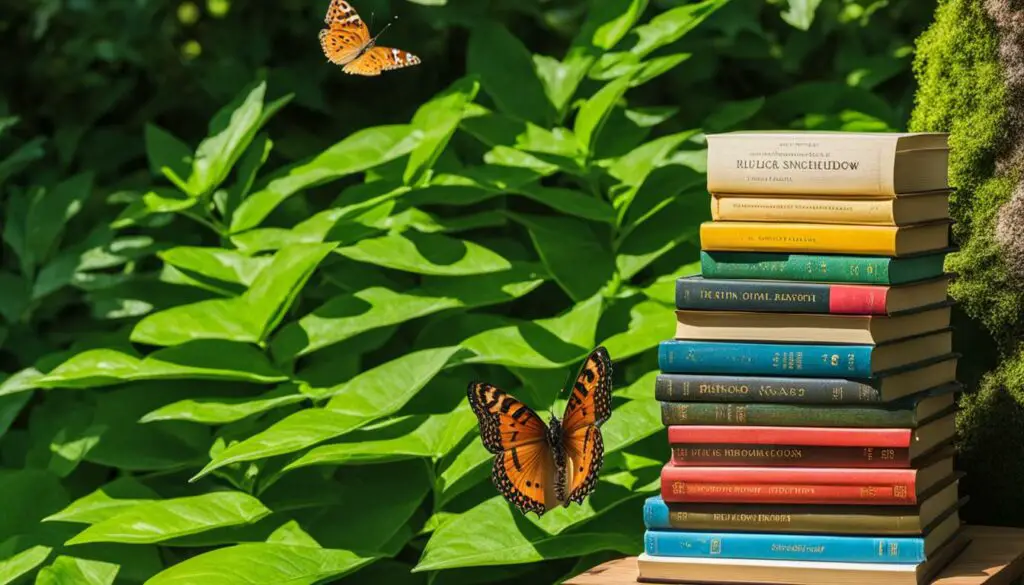
Raise On Stem Cuttings
When it comes to providing a sustainable food source for your caterpillars, milkweed stem cuttings are a great option. By placing the cuttings in water, you can keep them fresh for longer periods and ensure that your caterpillars have a readily available food supply. To make the process even more convenient, there are a few butterfly gardening tools that can help you keep the milkweed cuttings hydrated and easily accessible.
Floral Tubes and Racks
One useful tool for raising caterpillars on stem cuttings is the floral tube. These small, clear tubes can be filled with water and used to hold individual milkweed stems. The tubes keep the stems upright and secure, allowing the caterpillars to feed easily. To organize multiple tubes, you can use a rack that holds them in place. These racks are designed to keep the tubes stable while preventing tipping or spilling.
Using floral tubes and racks not only makes it easier for the caterpillars to access the milkweed, but it also keeps the cuttings fresh for longer. This means that you don’t have to constantly replace the food source, saving you time and effort in the long run.
Table: Butterfly Gardening Tools for Stem Cuttings
| Tool | Description |
|---|---|
| Floral Tubes | Clear tubes that hold water and keep milkweed stems fresh for caterpillars. |
| Racks | Organize and secure floral tubes, preventing tipping or spilling. |
With the right tools, raising caterpillars on stem cuttings can be a seamless and efficient process. By providing a sustainable food source, you can ensure that your caterpillars have the nourishment they need to grow and thrive.
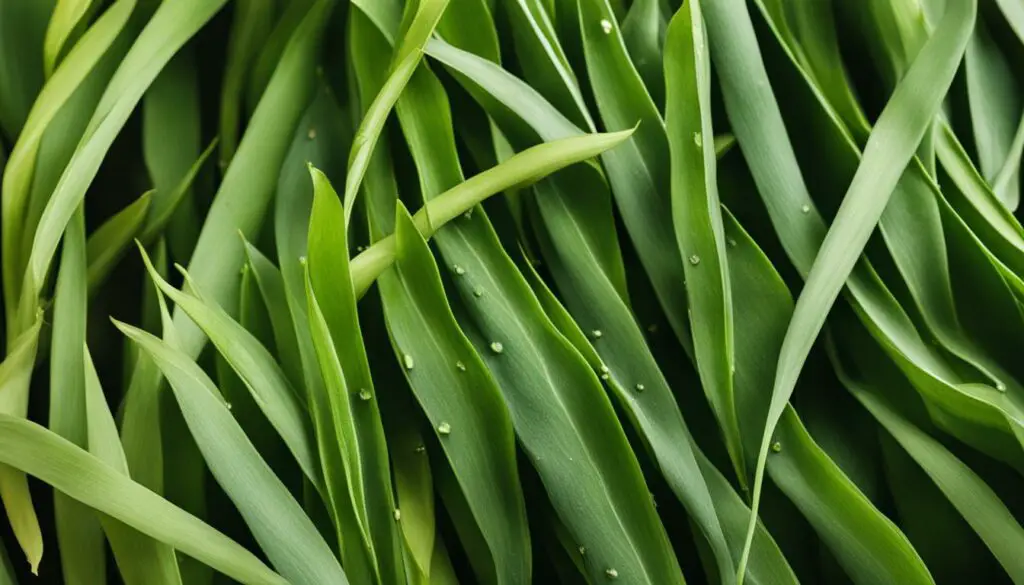
By using floral tubes and racks, I’ve found it much easier to raise caterpillars on stem cuttings. Not only does it make feeding more convenient, but it also extends the freshness of the milkweed. My caterpillars have been thriving, and I’ve seen a noticeable decrease in the time and effort required to maintain their food supply. It’s a simple solution that has made a big difference in my butterfly rearing experience.
So, if you’re considering raising monarch butterflies or other species on stem cuttings, I highly recommend investing in some floral tubes and racks. These butterfly gardening tools will make the process smoother and more enjoyable, allowing you to provide a sustainable food source for your hungry caterpillars.
Monarch Eggs and Caterpillars
When it comes to raising butterflies, finding monarch eggs or caterpillars in the wild can be a thrilling experience. However, it’s not always easy to stumble upon these delicate creatures in their natural habitat. That’s where reliable sources for purchasing monarch eggs, caterpillars, and chrysalises come in handy. These suppliers specialize in providing high-quality specimens for butterfly enthusiasts like myself who are eager to embark on the exciting journey of butterfly rearing.
By purchasing monarch eggs or caterpillars from reputable sources, I can ensure that I have a healthy population to care for and observe throughout their life cycle. This not only allows me to witness the fascinating transformation from caterpillar to butterfly firsthand but also contributes to the conservation efforts aimed at preserving these beautiful creatures.
Reputable Suppliers for Monarch Eggs and Caterpillars
Here are some reputable suppliers that I highly recommend:
- Butterfly Farms: With a focus on sustainable butterfly farming, Butterfly Farms offers a wide selection of monarch eggs, caterpillars, and pupae. Their specimens are carefully raised under optimal conditions, ensuring healthy and robust butterflies.
- The Butterfly Boutique: This online store provides a variety of butterfly-raising kits that include monarch eggs, caterpillars, or chrysalises. They also offer informative guides and resources to help beginners get started on their butterfly-rearing journey.
- Monarch Watch: As a nonprofit organization dedicated to monarch conservation, Monarch Watch offers monarch eggs and caterpillars as part of their educational programs. By purchasing from them, I not only support their conservation efforts but also gain access to valuable educational materials.
These suppliers have a wealth of knowledge and expertise in rearing monarch butterflies, and they prioritize the health and well-being of their specimens. By purchasing monarch eggs or caterpillars from these reputable sources, I can confidently begin my butterfly-raising adventure with the assurance that I am providing a safe and nurturing environment for these incredible creatures.
Cage Cleaning Supplies
Proper cage cleaning is crucial for maintaining a healthy environment for your butterflies. The following table provides a list of essential cage cleaning supplies and accessories that will help you keep your butterfly rearing area clean and hygienic. With these items, you can ensure that your butterflies are safe from harmful bacteria and diseases.
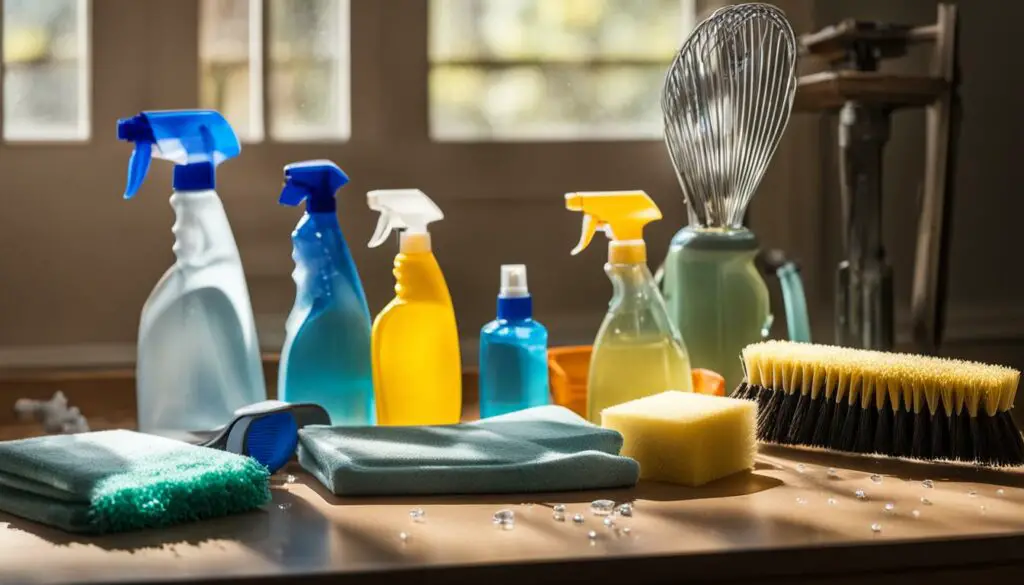
| Item | Description |
|---|---|
| Disinfecting Bleach | A powerful disinfectant that kills bacteria, viruses, and fungi. Dilute with water and use it to clean the cage surfaces and accessories. |
| Disinfecting Wipes | Convenient and pre-moistened wipes infused with disinfectant. Ideal for quick and easy cleaning of cage surfaces. |
| Cordless Keyboard Vacuum | A compact and portable vacuum cleaner designed to remove dust, debris, and frass from the cage. Its cordless design allows for easy maneuverability. |
| Frass Catcher | A specialized tray or container that collects caterpillar droppings (frass). It helps prevent frass from building up in the cage and ensures a clean environment. |
Additional Recommendations
In addition to these cleaning supplies, it is important to establish a regular cleaning routine. Here are a few tips to keep in mind:
- Remove any uneaten food, dead butterflies, and frass from the cage daily.
- Wash the cage with soap and water thoroughly at least once a week.
- Always rinse off cleaning agents before reintroducing butterflies to the cage.
- Ensure that all cleaning supplies are stored in a clean and dry area to prevent contamination.
Remember, maintaining a clean and hygienic environment is essential for the health and well-being of your butterflies. By investing in the right cage cleaning supplies and following proper cleaning practices, you can create a safe and comfortable space for your butterflies to thrive.
Tagging & Tracking Monarch Butterflies
Tagging and tracking monarch butterflies is a fascinating way to contribute to their conservation and gain valuable insights into their migration patterns. By participating in tagging programs, you can help scientists and researchers gather data that is essential for understanding the dynamics of monarch populations and their journeys across North America.
One popular tagging program is the Monarch Watch Tagging Program, which allows individuals and groups to tag monarch butterflies and record important information such as the location, date, and tag number. These tags, consisting of a unique code and contact information, are attached to the wings of monarch butterflies before they are released. If a tagged butterfly is recaptured or found during its migration, the finder can report the tag number, contributing valuable data to the research.
“Tagging monarch butterflies is not only a way to contribute to science but also a memorable experience. It’s amazing to think that by attaching a small tag, we can potentially track the incredible journey of a butterfly thousands of miles away.”
Participating in a tagging program is easy and accessible to everyone. All you need are tagging kits, which typically include tags, a tagging device, and instructions. These kits can be purchased from organizations such as Monarch Watch or obtained through local conservation groups and butterfly gardens. Additionally, many tagging programs provide resources and training materials to ensure proper tagging techniques and accurate data collection.
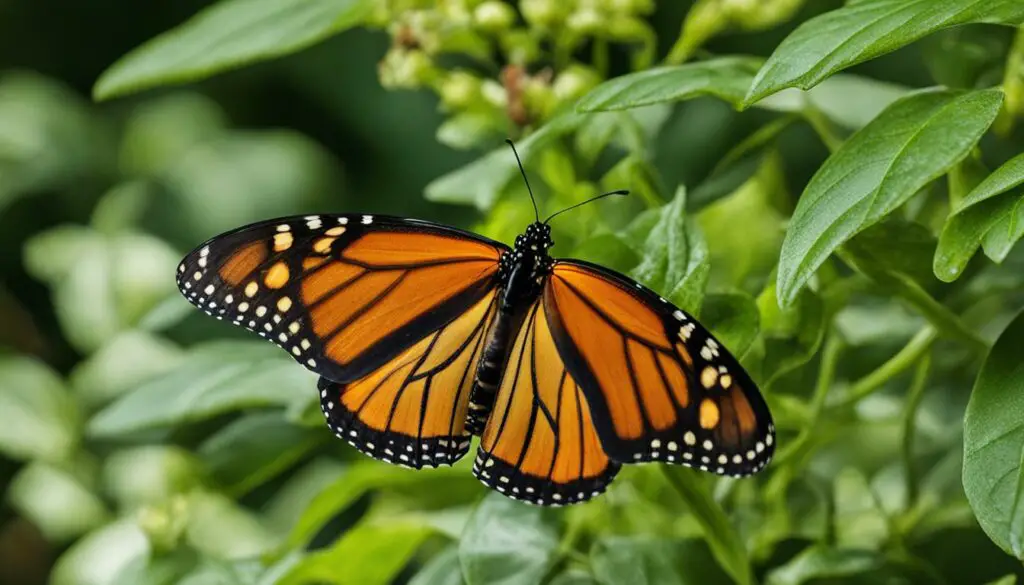
The Benefits of Tagging & Tracking Monarch Butterflies
Tagging and tracking monarch butterflies offer several benefits to both individuals and the scientific community. Firstly, it allows us to better understand the migration patterns and behavior of monarchs. By tracking their movements, we can gain insights into their habitat preferences, breeding grounds, and potential threats they face along their journey.
Secondly, tagging monarch butterflies provides an opportunity for citizen scientists to actively participate in conservation efforts. It allows individuals of all ages and backgrounds to engage with nature, contribute to scientific research, and develop a deeper appreciation for these iconic insects.
Finally, the data collected through tagging programs contributes to the overall conservation of monarch butterflies. Researchers can use this data to inform habitat restoration efforts, develop effective conservation strategies, and advocate for the protection of critical monarch habitats.
| Benefits of Tagging & Tracking Monarch Butterflies |
|---|
| Understanding migration patterns and behavior |
| Engaging citizen scientists in conservation efforts |
| Contributing to monarch butterfly conservation |
Butterfly Raising T-shirts, Sweatshirts, & Hoodies
Express your passion for butterfly raising with our fabulous collection of t-shirts, sweatshirts, and hoodies! Our merchandise is designed to celebrate the beauty of butterflies and showcase your love for this captivating hobby. Whether you’re a seasoned butterfly enthusiast or just starting out, our stylish apparel is the perfect way to showcase your dedication to butterfly rearing.
Our butterfly raising t-shirts are available in a variety of designs and sizes, ensuring a perfect fit for everyone. From vibrant prints featuring colorful butterflies to minimalistic designs highlighting the elegance of these winged creatures, our collection offers something for every butterfly lover. Crafted from high-quality materials, our t-shirts are comfortable to wear and designed to withstand the test of time.
If you prefer a more cozy option, our sweatshirts and hoodies are the perfect choice. Made from soft and warm fabrics, they are ideal for chilly days spent tending to your butterfly garden. With eye-catching designs and intricate details, our sweatshirts and hoodies are sure to turn heads and spark conversations about your fascinating hobby.
So why wait? Show off your passion for butterfly rearing with our unique and fashionable t-shirts, sweatshirts, and hoodies. Order yours today and let the world know about your remarkable journey as a butterfly enthusiast!
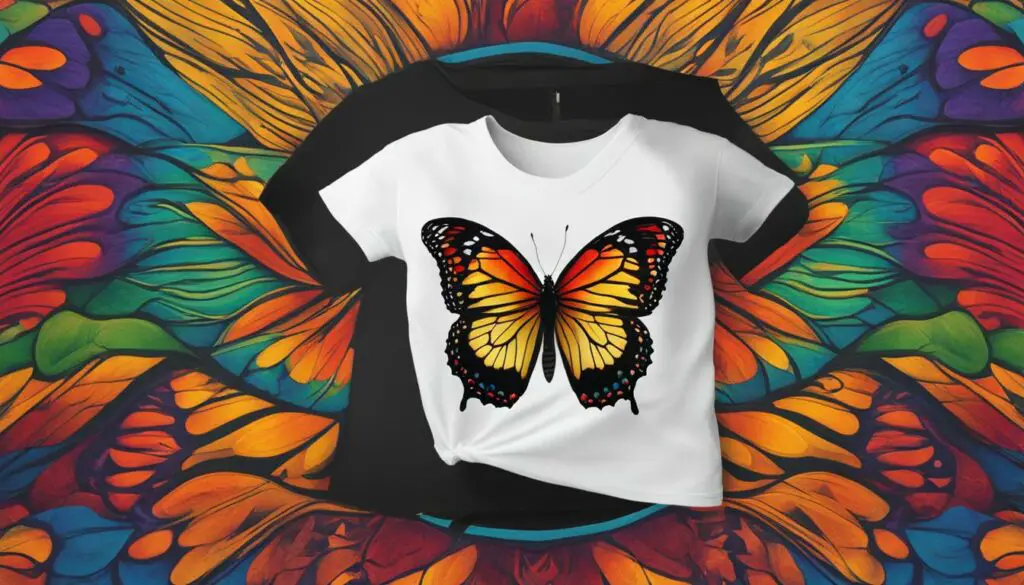
Butterfly Raising Articles
If you’re looking to expand your knowledge on butterfly rearing, there are plenty of informative articles available that cover various aspects of this captivating hobby. Whether you’re a beginner or have some experience, these articles will provide you with valuable insights and tips to enhance your butterfly raising journey. Here are some recommended articles to help you further refine your skills:
1. How to Start Raising Monarch Butterflies
This article provides a step-by-step guide on how to get started with raising monarch butterflies at home or in a school setting. It covers essential topics such as finding and caring for monarch eggs, creating a suitable habitat, and ensuring the health and wellbeing of the caterpillars throughout their lifecycle.
2. Survival Tips for Raising Monarchs Indoors
Raising monarch butterflies indoors requires careful attention to their specific needs. This article offers practical tips on maintaining optimal temperature and humidity levels, providing proper nutrition, and preventing common challenges such as disease and predation. It also addresses the importance of cleanliness and hygiene in ensuring the success of your butterfly-raising venture.
3. Identifying Butterfly Genders: A Guide for Butterfly Enthusiasts
Understanding the difference between male and female butterflies is essential for breeding and population management. This informative article provides detailed explanations and illustrations to help you identify the distinguishing characteristics of butterfly genders, enabling you to make informed breeding decisions and contribute to the conservation of butterfly populations.
4. Preventing Common Butterfly Diseases: Insights and Strategies
Butterflies can be susceptible to various diseases and infections, making disease prevention crucial for their health and survival. This article offers insights into common butterfly diseases, their causes, symptoms, and preventive measures. By implementing these strategies, you can minimize the risk of disease outbreak and ensure the well-being of your butterfly population.
By diving into these informative articles, you’ll gain a deeper understanding of butterfly rearing and learn valuable techniques to enhance your success as a butterfly enthusiast. Remember to always approach butterfly raising with care, patience, and a commitment to preserving these beautiful creatures for generations to come.
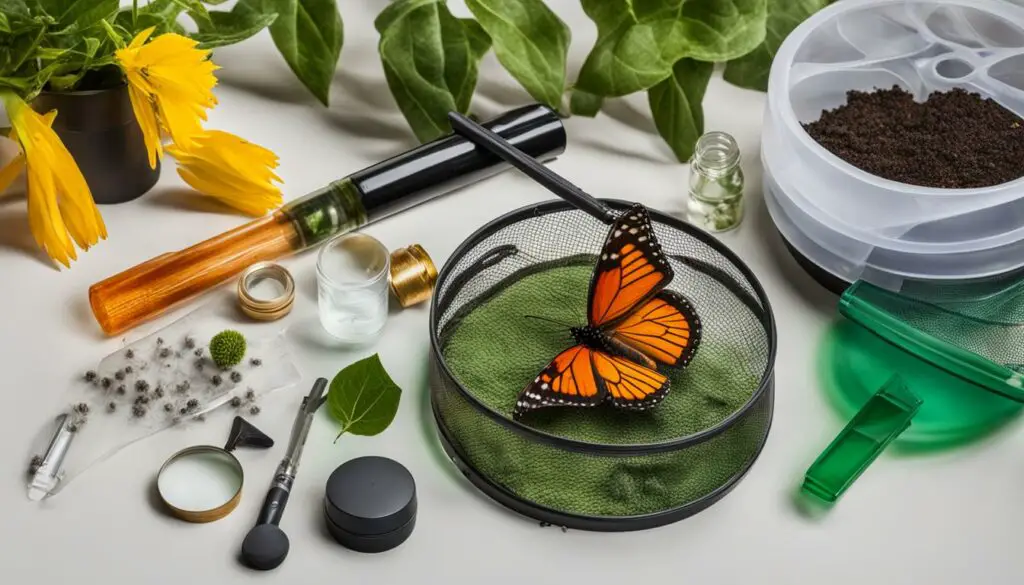
Raising Resources for Schools
As an educator, I understand the importance of engaging students in hands-on learning experiences. Butterfly rearing is not only a fascinating activity but also a valuable tool for teaching various subjects, including biology, ecology, and environmental conservation. In this section, I will provide you with valuable resources and recommendations specifically designed for schools to enhance your butterfly rearing journey.
Raising a School Butterfly Garden
Creating a school butterfly garden is an excellent way to incorporate butterfly rearing into your curriculum. It provides students with the opportunity to observe the complete life cycle of butterflies and learn about their importance in the ecosystem. To start a school butterfly garden, you will need suitable outdoor space, native plants, and caterpillar care supplies. Below is a list of recommended resources to help you get started:
| Resource | Description |
|---|---|
| Monarch Waystation Program | A program by Monarch Watch that provides guidelines for creating and certifying butterfly-friendly habitats |
| Butterfly Gardening: Creating Summer Magic in Your Garden | A book by the Xerces Society that offers guidance on creating butterfly-friendly gardens |
| Butterfly Kits | Complete kits that include caterpillar cages, milkweed seeds, and educational materials |
| Butterfly Rearing Supplies | Essential supplies such as caterpillar tents, magnifying glasses, and rearing containers |
Monarch Teacher Network
The Monarch Teacher Network is a nationwide organization that offers professional development opportunities for educators interested in teaching about butterfly conservation. By joining the network, you gain access to workshops, curriculum resources, and a community of like-minded educators passionate about butterfly rearing. Visit their website for more information on how to get involved and bring the magic of butterflies into your classroom.
Engaging students in butterfly rearing not only fosters a deeper understanding of the natural world but also instills a sense of responsibility and care for our environment. By providing the necessary resources and support, we can empower the next generation to become caretakers of our planet and advocates for butterfly conservation.
Butterfly Farming Accessories/Breeding Supplies
When it comes to butterfly farming, having the right accessories and breeding supplies is essential for success. These tools will help you create an optimal environment for your butterflies, ensuring their health and well-being. Whether you’re a seasoned butterfly farmer or just getting started, here are some must-have items to consider:
Butterfly Cages
Butterfly cages are the heart of your butterfly farming operation. They provide a safe and controlled space for your butterflies to grow and develop. Look for spacious and well-ventilated cages made of fine mesh to prevent any escapes or unwanted visitors. Ensure the cages are easy to clean and maintain, as hygiene is crucial for the health of your butterflies.
Insect Aspirators
Insect aspirators are handy tools that allow you to gently collect and handle delicate butterflies and their eggs. These devices use suction to capture the insects without causing harm. They are particularly useful when moving butterflies from one cage to another or when inspecting eggs and caterpillars. Choose an aspirator with a fine mesh tip to prevent any accidental damage.
Butterfly Nets
Butterfly nets are essential for capturing butterflies in the wild or from your garden. Look for nets that are lightweight, easy to handle, and have a long handle for extended reach. The netting should be soft and gentle, ensuring minimal harm to the butterflies during capture. Remember to handle the butterflies with care and release them safely after observing or breeding.
| Item | Description |
|---|---|
| Butterfly Cages | Spacious and well-ventilated cages made of fine mesh |
| Insect Aspirators | Tools for gently collecting and handling delicate butterflies |
| Butterfly Nets | Lightweight nets for capturing butterflies in the wild or garden |
In butterfly farming, having the right accessories and breeding supplies is crucial for creating a nurturing environment for your butterflies. From spacious and well-ventilated cages to gentle insect aspirators and lightweight butterfly nets, these tools will help you in your butterfly farming journey. Remember to always prioritize the health and well-being of your butterflies, ensuring that they are handled with care and released safely after observing or breeding.
By investing in the right accessories and breeding supplies, you can enhance your butterfly farming experience and contribute to the conservation of these beautiful creatures. Creating a safe and optimal environment will not only benefit your butterflies but also provide you with the joy and satisfaction of witnessing the miracle of metamorphosis firsthand. Start building your collection of butterfly farming tools today and embark on a rewarding journey of butterfly rearing!
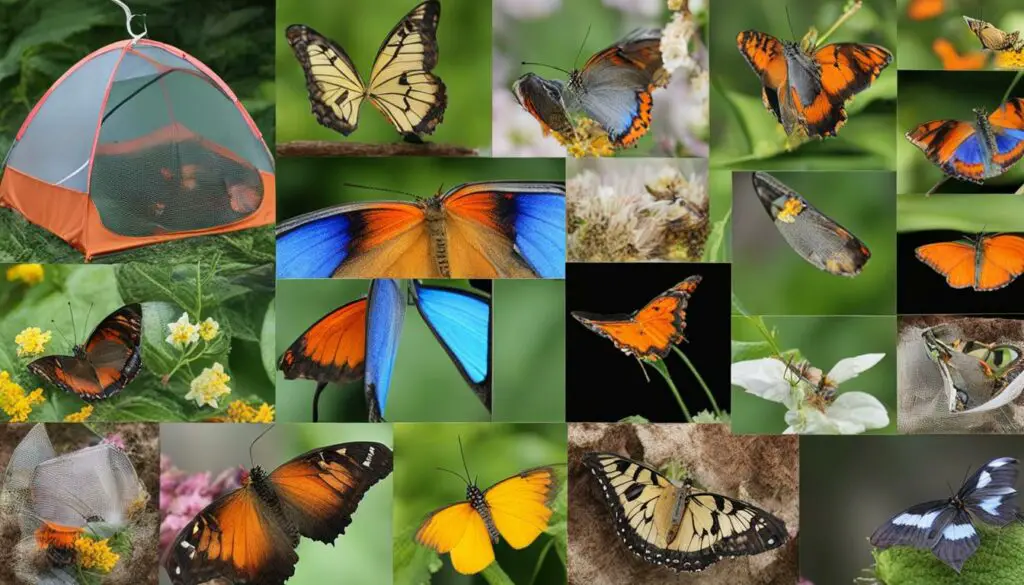
Conclusion
In conclusion, with the right tools and resources, butterfly rearing can be a rewarding and educational experience. By following the recommendations and tips provided in this guide, you’ll be well-equipped to raise healthy and vibrant butterflies, contributing to their conservation efforts and enjoying the beauty of nature in your own home.
Whether you’re a beginner or an experienced butterfly enthusiast, creating the perfect environment for butterfly rearing is essential. From sourcing milkweed seeds and plants to providing the right caterpillar cages, this comprehensive guide has covered all the essentials.
Educating yourself with informative books and articles, using stem cuttings to prolong your milkweed supply, and even tracking and tagging monarch butterflies are all aspects you can explore to enhance your butterfly raising journey.
Furthermore, if you’re interested in involving your school or taking your butterfly rearing to the next level, there are resources and accessories available specifically designed for classrooms and butterfly farming.
FAQ
Where can I find milkweed seeds, plants, plugs, and cuttings?
There are various sources where you can find milkweed resources. Local nurseries, gardening centers, and online seed suppliers are great places to start your search. You can also consider joining local gardening groups or butterfly enthusiast communities to connect with other butterfly raisers who may have extra milkweed plants or seeds to share.
What type of caterpillar cages should I use?
There are different options for caterpillar cages, but it’s important to choose a cage that is safe and easy to clean. Pop-up cages are a popular choice as they are portable and can be easily stored when not in use. Look for cages with fine mesh to prevent caterpillar escape and keep out predators. The size of the cage will depend on the number of caterpillars you plan to rear.
Should I choose window cages or clear mesh cages?
The choice between window cages and clear mesh cages depends on whether you plan to raise butterflies indoors or outdoors. Window cages provide a clear view of the butterflies but may not offer as much ventilation as clear mesh cages. Clear mesh cages allow better airflow and are suitable for outdoor use, but may not provide a clear view. Consider your specific circumstances and choose accordingly.
Where can I find informative books on butterfly rearing?
There are several books available that provide step-by-step guides and tips for raising healthy monarch butterflies. You can find these books at local bookstores, online retailers, or borrow them from your local library. Some recommended titles include “The Life Cycles of Butterflies” by Judy Burris and Wayne Richards, “Monarchs and Milkweed” by Anurag Agrawal, and “Butterfly Gardening for Texas” by Geyata Ajilvsgi.
How can I keep milkweed stem cuttings fresh for my caterpillars?
Floral tubes and racks are useful tools for keeping milkweed stem cuttings hydrated. Simply place the cut end of the milkweed stem into the tube filled with water and secure it in the rack. This way, the milkweed cuttings will stay fresh, providing a sustainable food source for your hungry caterpillars.
Where can I purchase monarch eggs, caterpillars, and chrysalises?
If you’re unable to find monarch eggs or caterpillars in the wild, there are reputable sources where you can purchase them. Online butterfly farms and conservation organizations often offer monarch eggs, caterpillars, and chrysalises for sale. Just make sure to choose a reliable source that follows ethical practices and prioritizes the well-being of the butterflies.
What supplies do I need for cleaning the caterpillar cages?
Proper cage cleaning is essential for maintaining a healthy environment for your butterflies. Disinfecting bleach, disinfecting wipes, cordless keyboard vacuums, and frass catchers are supplies that can make cage cleaning easier and more effective. Regular cleaning with these tools will help prevent the spread of diseases and ensure the well-being of your butterflies.
How can I get involved in tagging and tracking monarch butterflies?
Tagging and tracking monarch butterflies is a great way to contribute to butterfly research and conservation efforts. Several tagging programs are available for both eastern and western monarchs. Organizations such as Monarch Watch and the Southwest Monarch Study provide resources and guidelines for tagging monarch butterflies. Visit their websites to learn more about how you can get involved.
Where can I find butterfly-themed clothing and accessories?
Show off your love for butterfly raising with stylish and unique t-shirts, sweatshirts, and hoodies. There are collections available that celebrate and promote butterfly rearing as a fun and fashionable hobby. You can find butterfly-themed clothing and accessories online through retailers specializing in nature-inspired apparel or butterfly conservation organizations.
Where can I find articles on butterfly rearing?
There are several informative articles available that cover various topics related to butterfly rearing. You can find these articles online through butterfly enthusiast websites, gardening blogs, and conservation organizations. Some recommended articles include “How to Start Raising Monarch Butterflies,” “Survival Tips for Raising Monarchs Indoors,” “Identifying Butterfly Genders,” and “Preventing Common Butterfly Diseases.”
What resources are available for butterfly rearing in schools?
Engage students in the wonders of butterfly rearing with resources specifically designed for classrooms. Tips for starting a school butterfly garden, book recommendations for classroom activities and experiments, and information on joining the Monarch Teacher Network are available. These resources provide educational materials and support for teachers and students interested in butterfly rearing and conservation.
Where can I find butterfly farming accessories and breeding supplies?
If you’re considering taking your butterfly rearing to the next level, there are a wide range of butterfly farming accessories and breeding supplies available. Cages, habitats, nets, insect aspirators, and more can be found online through specialized butterfly farming supply stores or butterfly conservation organizations. These supplies will help you create a productive and nurturing environment for raising butterflies.

